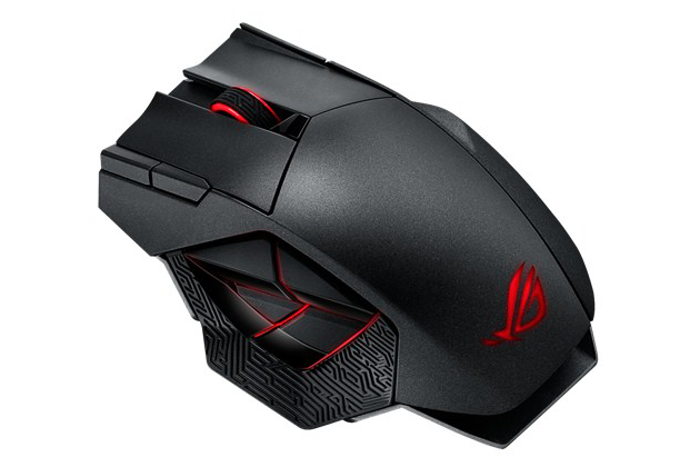
The new mouse is based on an 8,200DPI laser sensor with a tracking speed of 150 inches per second and a tracking acceleration of 30g. The sensitivity can be easily changed in mid-game by simply pressing a button. There are wired and wireless modes provided as well, cranking out a maximum 2,000Hz polling rate (a measure of responsiveness) in the wired mode and a maximum 1,000Hz polling rate in the wireless mode.
Asus says the wireless component uses a high-speed 2.4GHz connection to communicate with the PC, lowering latency and speeding up data throughput. In wired mode, the mouse connects via a USB 2.0 port and can receive a charge through this method, or by using the provided charging dock. The mouse comes with a braided 78-inch cable and a 40-inch rubber cable.
The new ROG Spatha can be customized thanks to an easy-swap switch socket design. Both the main left and right buttons use the OMRON D2FC-F-7N switch that has a 20-million-click lifespan, but Asus has also thrown two additional OMRON D2F-01F switches into the package in case the main buttons need to be replaced. Asus provides a full list of compatible OMRON D2F Series and D2FC Series switches on the product page.
Input-wise, there are twelve programmable buttons, six of which are mounted on the left side of the mouse body and arranged to resemble the Asus ROG eye. These buttons use Alps switches that provide tactile feedback; the two main OMRON switches provide tactile feedback as well so you know your mouse commands are being received by the game at hand.
That said, this mouse is not made for left-handed PC gamers. Instead, it’s designed for right-handed “palm- and claw-grippers” and provides a steel-gray non-stick coat and textured Mayan-stenciled rubber panels to help gamers firmly grip the peripheral. The mouse can withstand a beating too, thanks to the premium magnesium alloy chassis.
When it comes to the RGB LED lighting, the scroll wheel, the side buttons, and the ROG logo are illuminated and feature six cool presets that can be changed using the ROG Armoury Dashboard software: Static, Breathing, Color Cycling, Trigger, Random, and Battery modes. The mouse itself provides built-in flash memory so that users can save up to five profiles and take them wherever the mouse goes.
The ROG Armoury Dashboard interface can be downloaded from Asus, and enables users to customize the profiles, the lighting effects, and the program macros. Here you can assign commands to each of the twelve buttons, calibrate the mouse to perform optimally on your desktop and/or mousepad (like the ROG Whetstone), assign the lighting effects, and so on.
Overall, the ROG Spatha package contains the mouse, the wireless receiver/charging dock, the USB cables, the two OMRON switches, a carrying case, a star-head screwdriver, ROG stickers, and an ROG certificate. The mouse is presumably available now, but the company does not indicate the actual cost on the product page or in the announcement, so stay tuned.
Editors' Recommendations
- The Asus ROG Ally just got a game-changing update
- I tested 3 years of mini-LED gaming laptops, and I was shocked by the results
- MSI and Asus just flipped the script for their OLED gaming monitors
- The ROG Ally 2 is coming. Here’s why that’s a great sign
- Samsung’s new OLED gaming monitor might have a problem


